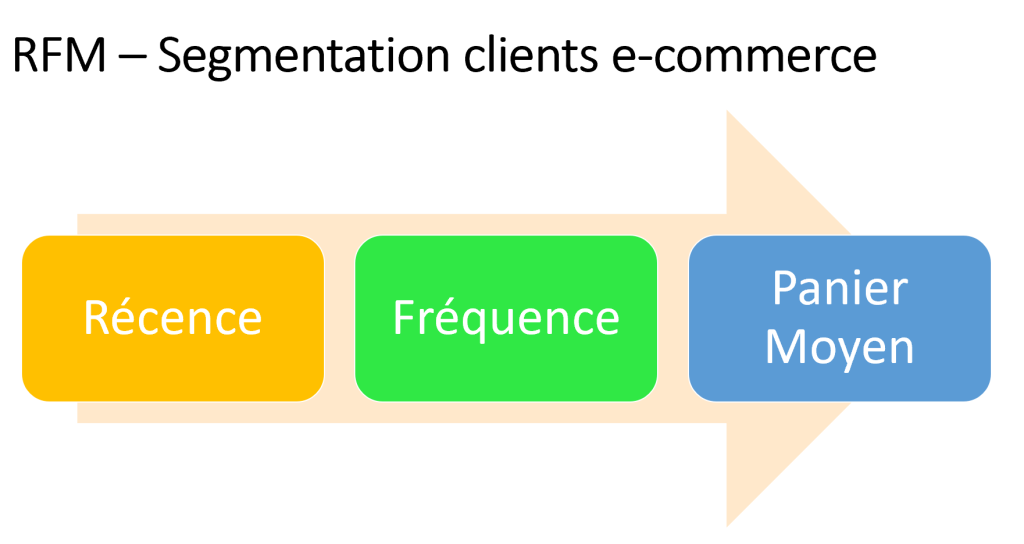RFM customer segmentation for e-commerce and stores
RFM is a method of segmenting the customers of an online or traditional store to determine the best follow-up to give them, optimize the use of available sales and promotional resources, and increase sales by optimizing resources. The RFM in-store sales method Here are the three figures to consider, but beware: the customer who spends […]
RFM is a method of segmenting the customers of an online or traditional store to determine the best follow-up to give them, optimize the use of available sales and promotional resources, and increase sales by optimizing resources.
The RFM in-store sales method

- Recency of customer’s last visit. A customer who bought a week ago is more interesting than one who bought a year ago.
- Frequency: does the customer buy every week or every year?
- Average = average basket. A customer who spends $1,000 each time is more attractive than one who spends $100 each time.
Here are the three figures to consider, but beware: the customer who spends $100 every week is more interesting than the one who drops in once a year to spend $1,000.
Customer typology and strategy
Generally speaking, we contact an e-commerce customer by e-mail and a store customer by telephone, but any combination is possible. The more important the customer, the more it’s in your interest to personalize exchanges.
- The big regular customer who’s been here recently is the most interesting. You need to offer them gifts, a loyalty card, invite them to events and treat them as a special customer. These are the 20% of customers who make up 80% of your sales. Some of these customers are demanding, difficult, even capricious. Try to serve them as well as possible and show them that they’re special. It’s these customers you should ask for referrals, as they’re likely to bring you other customers with a similar profile. But be careful not to give too many discounts and gifts, as a big customer can quickly become a costly one if you offer too many. Ideally, you need to develop new large customers so you don’t have to depend on them too much.
- A small regular customer who has just bought is an excellent customer, and you should try to grow them to replace the large regular customers on whom you are dependent, some of whom are bound to leave. You should also ask for references, as they can be interesting if used systematically.
- A large regular customer who hasn’t bought for a long time may be away competing, so unless he’s on a trip, you should try to contact him by e-mail or telephone with the pretext of offering him something or inviting him to an event.
- A large, low-frequency customer who hasn’t bought in a long time is probably lost. If it’s a store customer, call to offer him something, and if he refuses, ask why. It’s usually up to the store manager to do this, as the salesperson may have made a mistake with him or her.
- A small, low-frequency customer who hasn’t been to the store or e-commerce store for a long time is of little interest, so you should still try to follow up by e-mail. Please remember to comply with the laws of your country concerning e-mail or telephone solicitation.
Tracking equipment
For effective follow-up, you need to meet certain conditions;
- A simple, effective CRM for follow-up, so avoid all the big systems that are cumbersome and complicated to manage.
- Customizable e-mail templates
- Des scripts d’appels téléphoniques pour vos différents clients en fonction des différentes raisons de contact :
- New products
- Seasonal monitoring
- Promotions
- Events
- Calling up references
- Train your sales reps to make follow-up calls. Beware: this is an art that cannot be improvised, and requires a great deal of practice on the part of salespeople.
- Control your e-mails and calls: it’s not just your income, it’s also your image.
Conclusion
The RFM customer segmentation method enables you to track your customers dynamically, while making the best use of the limited resources at your disposal. A traditional business or e-commerce store should not be seen as a place to passively receive customers, but as a means of obtaining their contact details so that they can be dynamically tracked using CRM.
Jean-Pierre Mercier
